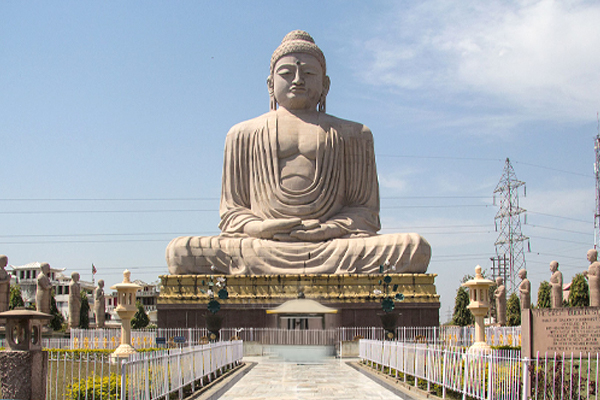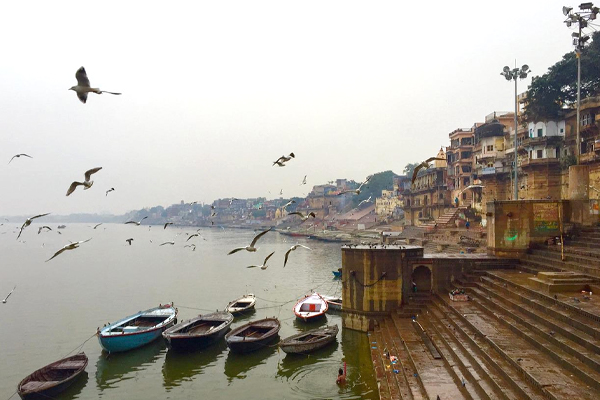Buddhist
Buddhist
Heritage / Religious
- Photo Friendly
- 6 Hours
- 3+ People
- All weather
Buddhist Pilgrimage Tour
Admire the amazing structural architecture and catch a peek of the art collections; the Buddhist Pilgrimage Tour is a fantastic tour with enormous moral significance. Among the Buddhist places included in our programmes are Varanasi, Bodhgaya, Kushinagar, Sravasti, and Lucknow. The voyage allows you to learn about the life of Lord Buddha, also known as Siddhartha Gautama. Each of these Buddhist places is unique in its own way. Take advantage of the greatest package to enjoy tranquillity, serenity, and Buddhist teachings.

Trip Itinerary
9 nights / 10 days Pilgrimage
Day 1: Arrive Delhi
Upon arrival, you will be met and transferred to your hotel.
Benefits include: Transfers, Breakfast, Lunch, Dinner, Stay Included
Day 2: Delhi - Haridwar - Rishikesh by bus (5h)
Drive to Agra after breakfast. Visit Mathura, Vrindavan, and Sikandra along the way. When you arrive in Agra, you will be transferred to your hotel. Overnight stay at a hotel.
Day 3: Agra - Varanasi (Overnight train)
Visit the Taj Mahal at sunrise in the early morning. Breakfast at the hotel, followed by a tour to the Agra Fort. Transfer to the railway station in the evening for the train to Varanasi. Overnight stay on board.
The Taj Mahal, the pinnacle of Mughal architecture, was created in memory of his queen Arjumand Bano Begum, dubbed ‘Mumtaz Mahal,’ by Mughal emperor Shah Jahan (1628-1658), grandson of Akbar the Great. Mumtaz Mahal was the niece of Empress Nur Jahan and the granddaughter of Emperor Jehangir’s wazir, Mirza Ghiyas Beg I’timad-ud-Daulah.
The Taj Mahal, the pinnacle of Mughal architecture, was created in memory of his queen Arjumand Bano Begum, dubbed ‘Mumtaz Mahal,’ by Mughal emperor Shah Jahan (1628-1658), grandson of Akbar the Great. Mumtaz Mahal was the niece of Empress Nur Jahan and the granddaughter of Emperor Jehangir’s wazir, Mirza Ghiyas Beg I’timad-ud-Daulah.
Day 4: Arrive Varanasi
Meet at the railway station in the morning and transfer to the hotel (We may get rooms after 12:00 hrs, but would try to get few rooms at least to wash & change) Later, go to SARNATH (where Buddha delivered his first sermon). Then it’s over to Varanasi for a city tour and some shopping. Overnight stay at a hotel.
Sarnath has the unique distinction of hosting Lord Buddha’s first discourse after gaining enlightenment 2500 years ago. It is around 10 kilometres from Varanasi and contains a variety of Buddhist landmarks, including the famed Dhamekh Stupa, the seat of the holy ‘Buddha.’ The remnants of Dharmarajika Stupa and Mulagandha Kuti Temple, where Lord Buddha is supposed to have rested and pondered while at Sarnath, are well worth a visit. The Ashoka Pillar, which was constructed by Emperor Ashoka, is a must-see in Sarnath. The Lion Capital atop this pillar is now India’s National Emblem, and it is notable for its superb workmanship and carvings.
Sarnath has the unique distinction of hosting Lord Buddha’s first discourse after gaining enlightenment 2500 years ago. It is around 10 kilometres from Varanasi and contains a variety of Buddhist landmarks, including the famed Dhamekh Stupa, the seat of the holy ‘Buddha.’ The remnants of Dharmarajika Stupa and Mulagandha Kuti Temple, where Lord Buddha is supposed to have rested and pondered while at Sarnath, are well worth a visit. The Ashoka Pillar, which was constructed by Emperor Ashoka, is a must-see in Sarnath. The Lion Capital atop this pillar is now India’s National Emblem, and it is notable for its superb workmanship and carvings.
Day 5: Varanasi - Bodhgaya
Early in the morning, drive for 8 hours to Bodhgaya. When you arrive in Bodhgaya, you will be transferred to your accommodation. Afternoon: Mahabodhi Temple and Bodhi Tree, Great Buddha Statue, Niranjana River, Sujata Temple – which is across the Niranjana River and a 30-minute stroll through the rice fields. Visit more Buddhist temples in Bodhgaya as well. Transfer to hotel in the evening. Overnight stay at a hotel.
Bodhgaya is one of the world’s most important and sacred Buddhist pilgrimage sites. Gautama attained supreme knowledge and became Buddha under a banyan tree known as the Bodhi Tree.
Bodhgaya is one of the world’s most important and sacred Buddhist pilgrimage sites. Gautama attained supreme knowledge and became Buddha under a banyan tree known as the Bodhi Tree.
Day 6: Bodhgaya - Kushinagar
Drive to Kushinagar early in the morning, stopping for a delicious lunch on the route. Check in at the hotel upon arrival. Overnight stay at a hotel.
Kushinagar, located 55 kilometres from Gorakhpur, is the site where the Lord Buddha spoke his final words “Now, comrades, I admonish you, declaring that deterioration is inherent in all constituent things! Work out your salvation with zeal! “and flew to the heavens. The Mahaparinirvana temple, a shrine devoted to the event, bears witness to the bereaved demise. Rambhar Stupa, one of Kushinagar’s many Stupas, deserves your attention since it is said to be the location where Lord Buddha was cremated.
Kushinagar, located 55 kilometres from Gorakhpur, is the site where the Lord Buddha spoke his final words “Now, comrades, I admonish you, declaring that deterioration is inherent in all constituent things! Work out your salvation with zeal! “and flew to the heavens. The Mahaparinirvana temple, a shrine devoted to the event, bears witness to the bereaved demise. Rambhar Stupa, one of Kushinagar’s many Stupas, deserves your attention since it is said to be the location where Lord Buddha was cremated.
Day 7: Kushinagar - Lumbini
After breakfast, visit Mahaparinirvana Temple (where Buddha breathed his final breath) and Rambhar Stupa (Lord Buddha’s cremation place), as well as Japan Temple.
Afternoon trip to Lumbini (5 hours) (Nepal). Stop at the India/Nepal border for Visa/Immigration procedures on route to Lumbini. Check-in at the hotel later. The Nepalese border is about a 15-minute drive away. Overnight stay at a hotel.
Afternoon trip to Lumbini (5 hours) (Nepal). Stop at the India/Nepal border for Visa/Immigration procedures on route to Lumbini. Check-in at the hotel later. The Nepalese border is about a 15-minute drive away. Overnight stay at a hotel.
Day 8: Lumbini - Sravasti
Visit Lumbini, the birthplace of Lord Buddha, during noon. Drive to Sravasti in the afternoon. Check in at the hotel upon arrival. Overnight stay at a hotel.
Sravasti, located 134 kilometres from Lucknow and 29 kilometres from Balrampur, is the capital of the ancient kingdom of Kosala and is famous for sheltering Buddha in the Jetavana Gardens for 24 rainy seasons. It is holy to Buddhists since Lord Buddha performed the Tirthika heretics here.
Sravasti, located 134 kilometres from Lucknow and 29 kilometres from Balrampur, is the capital of the ancient kingdom of Kosala and is famous for sheltering Buddha in the Jetavana Gardens for 24 rainy seasons. It is holy to Buddhists since Lord Buddha performed the Tirthika heretics here.
Day 9: Sravasti - Lucknow
Visit Sravasti in the morning, where Buddha spent his 24 monsoons, then Jetavana and the Ananda Bodhi Tree before driving to Lucknow. When you get in Lucknow, take the train to Delhi. Overnight stay on board.
Day 10: Arrive - Delhi - Departure
Meet our agent at the Delhi railway station and travel to the hotel for a freshen-up. Later, take a city tour of Old and New Delhi. Transfer to the airport in the evening to take the flight to your next destination.
The tour and services are completed.
Day 11: Baghi Chatti - Budhakedar (1530m) in 4h.
An easy day, all-downward, through fields and forests.
Day 12: Budakedar - Belak Khal (2750m) in 6h.
The route travels through a series of small villages, including Agund, Jhala, and Pangrana. Beautiful high-alpine landscape.
Day 13: Belak Khal - Lata (1700m) in 3h - Gangotri (3050m) by bus (5h).
We make our way down to Bhagirathi, one of the Gange’s tributaries. After that, we travel the 80 kilometres to Gangotri, a popular pilgrimage site.
Day 14: Gangotri - Bhojbasa (3800m) in 5h.
We go through a scenic path that is packed with porters, mules, pilgrims, and mobile traders. The glacier valley-of-flowers-trek.html widens from Raj Ghat, and we soon reach the Bhagirathi range, which peaks beyond 6500m.
Day 15: Bhojbasa - Gaumukh (3900m) - Tapovan (4450m) in 4h.
The panorama from Gaumukh, the Ganges’ source, is breathtaking, with praying pilgrims and half-naked sadhus meditating along the banks of the torrent stream that surges out of the glacier. The route winds through Gangotri moraines before arriving to Tapovan and its beautiful meadows, which are crisscrossed with streams and dotted with flowers. The panoramic view from here of Shivling (6540m), Meru (6660m), and the Bhagirathi massifs (above 6500m) is breathtaking. It is hardly unexpected that sadhus picked this location to meditate throughout the summer.
Day 16: Tapovan - Bhojbasa in 3h.
We peacefully appreciate the pleasures of this wonderful location in the morning. In the afternoon, we make our way to Bhojbasa.
Day 17: Bhojbasa - Gangotri in 4h.
In the afternoon, we visit the Gangotri temples.
Day 18: Gangotri - Uttarkashi (bus) in 6h.
Day 19: Uttarkashi - Delhi (bus) in 12h. (Hotel B&B)
Day 20:
At leisure in Delhi. Safety day for your international flight. (Hotel B&B)
Day 21:
Transfer to the airport and fly home.
Booking Request
Have a Question?
Feel free to reach out and we're happy to answer any questions you may have.
- +021 665544
- info@milestraveltours.co.nz
Does this look like fun? Book tickets today!
Comments are closed.
